Raise your hand if you have spent an obscene amount of time discussing the importance of practice to your students. ME!!! Despite practice records, playing tests, encouragement, and ample fussing, I am always surprised when someone tells me they don’t know what to do. So I talk about setting goals and what goals should look like. Then I talk about methods and the awesomeness of the handy phones we carry around and how AMAZING it is that we can record ourselves and listen back with ease. One student finally told me she took my advice and was thrilled that it helped. Oof. That was the push I needed to change a few things this year.
Practice records are helpful and can be a wonderful motivator, but what do we do when students need to learn to reflect and use those reflections to push their playing forward? Make a cool new Google Form that does just that!
I created the Pre- & Post- Practice Reflection Form in my Teachers Pay Teachers shop. Students will chose an excerpt to work on for the week, then write 2-3 things they want to improve with practice. They record a pre-practice video and upload it to the form, then get to work. At the end of the week, students will record a post-practice video and reflect on what they achieved and how they can improve their practice technique.
Students can use this experience for a class discussion about what they worked on and what they learned during the week. They can use what they’ve learned to help each other. It can inform rehearsal and sectional plans or it can be a powerful data collector.
We have become so good at facilitating reflection. It’s now time to help students use their reflections effectively. Let me know how it works for you!
I spend a ton of time (more than I care to admit) scrolling social media, and I always find wonderful teacher content to save for later. TikTok is my current favorite online space to find cool new things to try or hot takes to digest. Recently, during a scrolling session, I came across a new teacher asking veteran teachers for their best advice, and it got me thinking about what I would say if asked. I could go on and on about classroom management and music teacher organization, but I think the most valuable piece of advice I have is to have a routine for the first 10(ish) minutes of class.
This applies to classes/rehearsals at all levels. The first 10 minutes can make or break your lesson or rehearsal. If your students enter the room and don’t know what to do or what is expected of them, you are inviting chaos into the mix from the very start. We tend to think of routines as only being helpful for younger students, but I am amazed by how much they help me when I’m planning or when I have to be out for the day. My students can get started on their own and some classes can run themselves. A routine made that possible.
My routine consists of 5 parts: greeting, get ready, agenda, tuning, and warm-up.
Greeting
Some teachers have a special way they greet each student. Some stand at the door. I do a combination because I’m usually fixing instruments or putting out handouts. I try to greet each kid by name. When things are busy, I may skip that step and say a big hello to everyone once we are seated. Either way, my students know I see them and I’m glad they are here. It’s during this time that I take attendance. I do this mentally since I know my students so well, so it isn’t a huge step with a specialized method.
Get Ready
This refers to the time it takes students to come into the room, get their materials, and sit down. During the first few days of school, I model how I want my students to enter the room. Depending upon the grade level, they know where to put their things, how long they have to get their instruments out, and where to look for the day’s tasks.
Agenda
“Getting ready” leads to the agenda that is always on my interactive whiteboard. I have seen many ways to do this and they all work. You just have to choose what works best for you and your classes. I have gone from simply writing everything on the board to creating a slide for each class every day. I prefer this method because the slides serve as my lesson plans while keeping me on track as much as the kids. Furthermore, I share them in Google Classroom so that absent students can see what they have missed.
Here are my agendas by grade level:
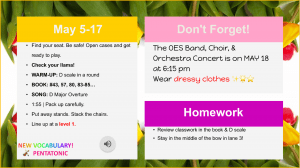
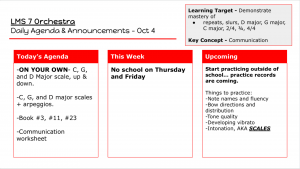
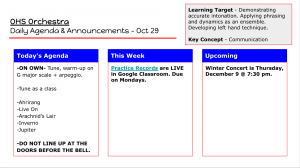
I also use agendas to keep students informed of what is coming up during the week or later in the year. Quiz reminders and concert dates get posted early and often during class. Having them on the board allots me time to answer questions and minimizes students not knowing what is happening. Though there is always one that is lost anyway!
Tuning
My tuning procedure varies by grade level. I tune my 5th-grade beginners with some assistance from more advanced students as needed. My middle school students use clip-on tuners once they get to their seats. I keep the tuners clipped to my conductor’s stand so I always know where they are and students return them after they tune. I walk around to help as needed, then check everyone by playing open strings. My high school orchestra tunes itself, though I have had to be more active in that process after the Covid quarantine.
Warm-up
The warm-ups are usually a scale or an exercise from a method book. I have had students do a warm-up on their own as bell work, and then review it as a class before moving on to the rehearsal. Sometimes the warm-up takes more than a few minutes, but it always leads to the rehearsal music. When teaching an arrangement of Jupiter to my high school orchestra, I wrote out a melodic figure for each section and challenged them to come up with fingerings. The sections being in unison helped the violins tune the part they had in the arrangement, and it forced the low strings to play in higher positions.
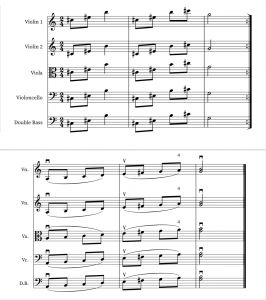
The slides were posted on the interactive whiteboard and section leaders came up to write their fingerings on the board. I was able to handily work on intonation and bow control because everyone was involved and challenged.
Of course, the first 10 minutes may take longer than 10 minutes, but the sentiment is always the same. Having a routine that students can count on and recreate will get your class off to a great start every day.
When my friend and colleague, Mr. Kurt Russell, came to me last spring with an idea, I wasn’t sure what would come of it. It was a fantastic idea: a semester-long elective seminar that explores American history through the lense of Black American Music. It was the course I always wanted to take and the course I always wanted to teach: a dream!
Allow me to pause and express how remarkable this scenario is. Kurt identifies as an African American man who was raised in Ohio with southern roots. I identify as a Black American woman who was raised in Ohio with southern and Caribbean roots. Kurt belongs to a population of Black male teachers who only make up 2% of teachers in the US. And I am one of the few Black orchestra teachers in Ohio. To be encouraged to teach a high school elective from our positionalities is a blessing that we didn’t take lightly.
We considered all the music that we could include, from the continent of Africa to the Caribbean, and we realized that there was simply too much for us to cover in a semester. Any genre could be an entire course! Guided by our own positionalities, experiences and musical loves, we decided to begin with the Middle Passage and end with Hip Hop. And for a first dive into this kind of course, it went very well.
The discussions were engaging and the lectures were enjoyable. Quizzes kept the students accountable, but Kurt’s use of the Socratic method is what kept the students coming back for more. I brought the musical knowledge and Kurt connected it to American history. I cannot believe how well it worked!
Kurt as since won the National Teacher of the Year Award and will assume his responsibilities away from the classroom next year, so we have a hiatus to plan and fine-tune our curriculum. Check out the Spotify playlist I curated for the semester. It is a living playlist, so it has changed throughout the year and I still have some organizing to do, but I would love to hear input. Let me know if you think anything is missing. Let me know if you want to teach a course like this too!
Happy New Year! I know it’s been a minute, but I’ve been a pretty busy orchestra teacher this year. Once the school year started everything took off so suddenly, and I haven’t had any time to update my blog.
Here is an overview of the things I’ve been doing since the beginning of the school year:
- I started the school year with a student teacher and she was fabulous! My district is small so I teach grades 5-12 Orchestra in three different buildings. So having a student teacher, especially one that is so wonderful, was a game-changer for me. We worked so well together and I was really sad to see her go. She successfully graduated from her undergraduate program this winter. I’m so excited for her and for what she will bring to music education in the future.
- I coached some of my high school students through cultural sensitivity issues in their classes this fall. It was very unfortunate, of course. But this is something that our students, our young people, need to learn how to do. Advocating for yourself is one of the most powerful tools that young adults need as they venture out into the world. So speaking up for themselves when they see injustice or feel as though something can be done in a less harmful way is very important. Having students advocate for themselves and how instruction is delivered definitely keeps teachers on their toes. Maybe that is what we need in this climate?
- I have been trying to manage my stress all fall. This job can be difficult at times. Even though there’s so much joy to be had, sometimes the stress and the workload can really outweigh the joy. The winter break has been just what I needed to reset and reflect. I hope you have had the chance to pause and recharge as well. Remember the JOY!
- I’m preparing to present with my department at the Ohio Music Educators Association Conference in February. Our topic is high-quality student data in the music classroom. Everywhere I look I see information being shared about what high-quality student data is and how to document it. But I see very little as it pertains to music educators, particularly teachers of ensembles. Playing tests are great, but how do we collect data for an entire ensemble that could be anywhere from 10 to 100+ students? After being inspired by my dear friend and colleague Dr. David Pope at Baldwin Wallace University, I created a Google Form to help me do just that. Now all I have to do is record my ensemble, fill out the form assessing the quality of their performance, then create a spreadsheet and use AutoCrat to populate the template. I can then save that document into a Google Drive folder that can be shared with my administrators or my department.
AND I have added this Google Form and Google Doc template to my Teachers Pay Teachers store. Give it a try and let me know what you think!
I have been making materials for my classrooms for years and I have finally gotten my life together (OK, not quite) enough to list them on Teachers Pay Teachers.
Right now, I have listed a few assessment tools I created in Google Forms, but more is to come! They have been a game changer for quick assessments and immediate feedback to my students. They require a little set-up, but I promise they are worth it!
Check out my shop: Hey Orchestra Lady and leave a review!

Rainbow colored block letters spelling out “Hey Orchestra Lady” with an arch of stringed instruments in the background.
What a year, eh? I’m accustomed to having joys and learning break-throughs peppered with some frustration, but this year was unreasonable every step of the way. If I remember correctly (at the end of a long day, who knows?), I have had three different learning scenarios to figure out so far. And doggone it, every time I seem to make it work more than it hinders, it gets changed again. My district is finally making the move to four days of in-person learning during the last quarter. The rub is that we have to teach in-person and e-learners at the same time everyday. I don’t know where to begin, but somehow I have to make it work once more. Last push until summer, amiright?
When I think about how we got here I realize how far we have come. Teachers were still operating under an analog model of learning. Digital tools were suddenly tossed in our laps and we had days to work out the kinks before trying our new toys with students. The biggest challenge of all was Zoom. We went from fumbling idiots to tech-savvy geniuses in a year’s time. Scheduling links, muting students, setting up polls, and making our own backgrounds? We got you! Do all of that while doing learning management system trainings and collecting all the free tech trials we can find? Hand us the Educator of the Pandemic Year Award!
To commemorate our year of Zoom, my friends and I created a video parody of Say Something by A Great Big World. Our video is called Zoom to You.
We sincerely hope you enjoy it. Please share it with your teacher friends. Be prepared to laugh… until you cry.
I’m not gonna lie: I’ve been making this up as I go along, but things are working out so far. Armed with my playlist for inspiration, I have led my students on a music theory journey to help them understand the form of the 12-bar blues. My search for materials led me to PBS’s The Blues classroom resources.
To get started, we learned about scale degrees and identified the tonic, subdominant, and dominant in C Major. I pop quizzed them orally to keep them on their toes! At any given time they know that I may ask them what the subdominant of F major is and they have to know it, or least be able to figure it out. Once they understood scale degrees, it was time to teach them about triads and how we build chords.
Since my 8th grade orchestra is virtual three days a week, we used the whiteboard feature in Zoom to determine the I, IV, and V chords in D Major: our favorite key. These are the bricks we are building our 12-bar blues with.
Today’s class was all about applying our new skills to write the chord changes and figure out a pattern for our bass line. A few YouTube videos led us to decide that we liked a 1-3-4-5 pattern. Every student worked to put the patterns with the correct chords in the correct place on our shared staff paper in Kami. It is all coming together nicely.
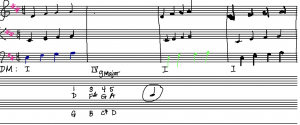
Student work-8th grade
I’ll admit that doing this virtually is more difficult than I thought it would be. I wanted to this to be mostly an aural experience. I know there is still time to get there, but I have to remind myself that understanding the basics will help my students be more open to experimenting and ultimately creating.
Once we have finished our blues progression, the students will learn to play it on their instruments. I’ll encourage experimentation with rhythms and articulation to discover what they like. The next step will be creating something to put on top of the progression. This is turning out to be a very rewarding experience for all of us.
I have no problem admitting that I am not comfortable improvising on my bass. It is a skill I wish I had cultivated well before now. My recent musical awakening to roots music and how Blackness has contributed to the richness of the genre, I have decided to explore improvisation with my middle schoolers. Being virtual for the first semester of the year has been hard on all of us and I am finding that the kids are getting burned out. And so am I! So this may be just the thing I need to inject some excitement into our playing.
I decided to use Christian Howes’s play-along YouTube playlist as a starting point. There are so many great videos to choose from, but I wanted to keep it simple so as not to scare anyone too much. The Feel Good Pop Play-Along in D Major seemed to be a winner when I tried it on my viola. It was so much fun and my students didn’t get discouraged! It led to great conversations that carried us to the next step.
I introduced boogie-woogie to my students. Armed with a killer playlist on Spotify, I played a few examples and asked them to identify the genre. I was inspired by a piece I picked out for my 6th graders this year: Pizzicato Boogie by Mekel Rogers. My students loved the 12-bar bass line, I thought that would be a good place to begin our experimenting. I found a wonderful resource by pianoTV on the genre, and I had my 8th graders take notes in their process journals. My plan is to help them document and reflect what they are learning in the hopes that it will lead to further inquiry.
My next step is to talk about the 12-bar blues chord progression and use scale degrees to help the students figure out the bass line by ear.
Now that my district is solidly in the second semester of this unprecedented school year, I finally feel that I have bandwidth to speak about how teaching in 2020 has affected me. I wanted to come back to my blog many time over the last few months, but my exhaustion wouldn’t let me. Instead, I have been more active on social media teacher groups to keep myself sane. Or at the very least, to try to keep my sanity. Whew. This has been quite a ride.
My district began online instruction in fall. It was a whirlwind of professional development sessions chock full of great ideas and resources that were definitely exciting. But we left those sessions feeling overwhelmed and confused about how to move forward. You know the feeling of having so many directions you can go that you can’t move? That is what it was like. My colleagues and I managed to push forward and come up with basic plans to get the year started.
My plan was pretty simple: check in with my students to pay attention to their emotional needs. Only then could I attempt to get into the music. I think we all had good intentions going in. Our administrators gave us encouragement to build relationships and then jump into content and we embraced it. Even still, I quickly realized that what should be done wasn’t what was being done. I still think this is a huge problem for Big Education right now.
We know we are all struggling. We know that the problems in education have been magnified for all to see. Yet, teachers are being pushed to maintain rigorous curricula and prepare for state testing which requires us to push our students more than we should. More than any of us can handle. I cannot count how many times I have taught my heart out to blank screens wondering if it was what any of us needed.
As the new year year got underway I began vocalizing my concerns to my husband and friends. I must have been on to something because a podcast episode smacked me in the head. If you haven’t been listening The Score: An Urban Music Education Podcast hosted by Eric Jimenez and Justin McLean, you need to get on it, fellow music educator. The topics are relevant to every teacher, everywhere. And they really hit the nail on the head in Episode 40 – Coded Language in the Virtual Music Classroom. Eric, Justin, and their guest, Coty Raven Morris, laid all my concerns out and validated them in a way that got my wheels turning. I highly recommend you listen and think about how we (all educators in all subjects) are trying to apply the same old approaches to the new normal of virtual learning.
I am exhausted, and I keep fighting my efforts to beat myself up for not coming up with new lessons and project ideas. Even though the circumstances are different and we knew that going into this school year, we are still being held to the same standards and expectations. It seems unfair to educators and students alike. How can those of us in the classroom give our students what they truly need when our leadership is making demands of us while also telling us to take care of ourselves? The mask of empathy is see-through.
My hope for 2021 is that education will begin the much needed shift to truly educating students, not just lining the pockets of testing companies. I hope that educators will be welcomed to the table and given space to voice our concerns and needs. I hope that Big Education will take a backseat and get out of our way. But ultimately, I hope we survive this in one piece. Check on your teacher friends, folks. We are not OK.
I have been quite busy these last few months. Since beginning the school year fully remote and having to figure out how to teach orchestra virtually (I’ll write a post about that shortly), I have taken on a a couple other roles.
I recently completed my Mentor Educator training for the State of Ohio and I’m so excited about it! I was thrilled to be asked to mentor a Resident Educator in my district. My mentee is a high school since teacher. It has been quite a ride getting to know her teaching style and remembering my high school science days. As I work with her, I have learned so much about myself and how I can use my skills to support a colleague. While the end goal is to assist a new teacher in their journey to become a professional, I grateful that I also have had the chance to meet and get to know a fantastic new addition to our team.
My social justice and equity work has been a passion project. One that is time-consuming and stressful, but also quite rewarding. Three opportunities fell in my lap that made me question my role in this work. I used to consider myself a sidelines gal. Always ready to lend a hand. A good man in a storm (Grey’s Anatomy reference!). So being asked to speak and present has been a crazy experience.
This fall I was honored to be ask by my fantastic colleague, David Pope, to speak to his Intro to Music Ed class about my positionality and experience as a Black woman music teacher. Meeting his class was a real treat and we had a lovely conversation.
I then created a session for the California Music Educators Association Bay Area Section title, “Beyond Repertoire: Social Justice and Equity in the Orchestra Classroom.” My idea was fairly simple: address how our programs must change to meet the needs of our students who now represent many diverse backgrounds. Working with Tiffany Ou was a true delight and I hope to partner up with her again.
And then I was baffled to be asked to contribute to an amazing panel discussion at the Midwest Clinic by Soo Han, another wonderful colleagues who teach orchestra. I was shocked and honored to be invited and it was great to share ideas with the rest of the panel.
Finding my public and professional voice is challenging to say the least. That being said, I truly think I may be of help to someone, so I’ll keep speaking up while feeling awkward and unsteady. Change has to begin somewhere. Maybe in this ness of a year, full of anxiety and strife, something good will come of being pushed to make myself heard.






